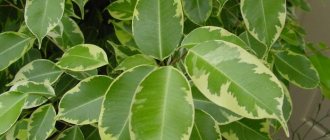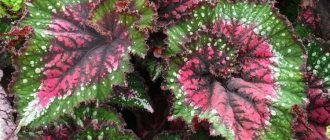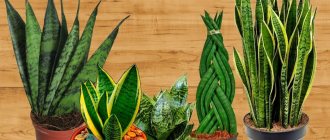Features of ficus
Ficus plants are united by several facts. Firstly, 90% of plants in the family are evergreens. Only 10% are deciduous. Secondly, domestic ficus , like its wild relatives, has whole leaves. This is a single “canvas” with a smooth edge.
Ficus leaves are often rounded. The shape resembles a circle and is associated with coins. Therefore, in Asia, for example, trees of the family are grown as money talismans.
The inflorescences of plants resemble balls or pears in shape. Buds develop on the inner surface. Flowers are usually small and light-colored. They are pollinated by hymenoptera insects, although ficuses reproduce, as a rule, vegetatively. Plants of the family easily form aerial roots. They become the basis for new trees.
House ficus blooms with small white flowers
Unites ficuses and habitat. Plants of the family prefer the tropics. You can find 800 species there. Rare varieties of ficus live in the subtropics. About 100 species were discovered there.
The names of ficus trees are different, but they have common features. Thus, plants are distinguished by the presence of milky juice in all their parts. The viscous elixir is found in the trunks, leaves, and roots. Some species also serve as a source of shellac. It is produced by the lacquer bug.
This insect lives in some ficus trees. The nutritional value of plants is clear from the example of the fig tree. Ficuses are also used in folk medicine. Tree sap eliminates benign uterine tumors. The medicine also fights mastopathy. In the first case, the juice is drunk, in the second, it is rubbed into the chest.
Description
Ficus plants belong to the Mulberry family (Moraceae).
The genus has about 900 species, among which there are vines, shrubs, and trees. The well-known fig (fig tree, fig tree) belongs to the Ficus genus. Representatives of different types of Ficus may have a minimum set of common features. So, for example, most of them lead a semi-epiphytic lifestyle, but there are varieties whose common name sounds like Strangler Ficus. The aerial roots of the latter entwine the tree, become lignified over time and actually “strangle” the owner. There are species that form a special life form - the banyan tree. As they grow, they can occupy an area of several hectares, with a crown circumference of several hundred meters.
However, despite all the external differences, Ficus trees also have a number of common features. For example, all plants have alternate or, less commonly, opposite leaves. The leaf blades are solid, may have a jagged edge, and in the vast majority of cases are lobed in shape.
In indoor culture, Ficuses bloom extremely rarely; they are mainly valued for their decorative foliage.
Types of ficus
Only 7 ficus trees are grown at home. The photo of the Dwarf variety only vaguely resembles powerful tropical trees. A tiny plant, a creeping shrub. Its leaves differ in tone and are variegated. Young plants have delicate, non-symmetrical foliage. In adult bushes it becomes thick, dense, and acquires the correct shape.
The tiny ficus belongs to the category of ampelous ones. All of them are spectacular in hanging flowerpots, but are finicky to care for.
Tiny ampelous ficus
It's easier to get a ficus benjamina . It is also creeping, but can also take on the outline of a tree. To do this, it is enough to weave thin trunks. Gradually, they will grow together, forming a single and powerful crown base.
can easily be trimmed at home This simplifies crown formation. The foliage is small and pointed at the ends. The grooves allow excess moisture to drain from the flower. Benjamin's homemade ficus does not suffer from moisture; rather, it needs it. Frequent spraying is required.
Ficus Benjamin was one of the first to be “tamed.” It belongs to trees and grows tall. The leaves alone reach 30 centimeters in length.
Young foliage is rolled into a tube. They are covered with reddish stipules. Later, the oval “cloths” bloom, acquiring a dark green color.
Ficus leaves can be of a regular green color, or they can be variegated, i.e. variegated
Ficus Rubber is a long-liver. It is this that is called Sacred in India, associating it with the personality of Buddha. The tree has one trunk at the beginning of life. But, over the years, the ficus begins to branch and grow. The result is an array of trees, the trunks of which grow together and intertwine.
Ficus bengal is a parasitic plant in nature. The life of a plant begins on the branches of other trees. The ficus reaches them with aerial roots, taking juices from the “hosts”. This makes it possible to put down new roots that reach the ground.
So, the Bengal ficus at home will also be covered with aerial roots. They are most often removed for aesthetics. This also helps control the size of the tree.
Bengal ficuses have aerial roots that can grow to incredible sizes.
In some countries, local residents build bridges in the jungle from ficus aerial roots.
Ficus Ali stands out for its non-standard foliage. It is long and thin. If you weave the trunks of several trees, you get a composition that resembles a palm tree. Growing Ali, florists call tango with ficus. Giving a plant the desired shape is reminiscent of a dance or the work of a sculptor. A tree makes it possible not only to take care of it, but also to act as a creator.
Ficus Ali can be considered interesting and different from ficus
The trunk of the Triangular Ficus is not so plastic. The foliage of the flower also requires attention. It was its shape that became the reason for criticism of the plant. Its leaves seem to be cut off in the middle, resembling triangles. And what does the process of caring for ficus trees resemble? Is this torture or a simple task?
Triangular ficus got its name for the unusual structure of its leaves.
Interesting! In some countries, from the aerial roots of ficus, local residents weave bridges over which they can cross to the nearest villages, between which there is no longer any communication.
Reproduction methods
In the natural environment, ficus trees reproduce by seeds and daughter branches (shoots). At home, these plants are bred in three ways:
- cuttings;
- leaves;
- air layering.
Most often, gardeners use cuttings. The cuttings are placed in water until roots appear, then planted in a pot.
Ficus flowers are unpretentious plants that require minimal care. These inhabitants of the tropics grow for many years and perfectly tolerate the changing seasons in the northern hemisphere.
5/5 — (1 vote)
Home care
Being residents of the tropics, ficus trees die if the temperature drops below 12 degrees Celsius. The ideal indicator is 20-25 degrees. This is exactly how much a flower needs during its growth period. It lasts from spring to autumn. At this time, plants require more water and frequent watering. In winter, ficuses drink only once every 10-13 days. The same interval applies to soil fertilizers applied in the summer.
What else does ficus require? Home care involves replanting, but only young plants. They renew the soil every two years. Mature trees do not need to be replanted at all. The main thing is to choose the right soil. The best option: - a mixture of peat, turf, sand and leaf soil. Turf predominates.
Pots for ficus plants are chosen to be cramped. This limits the growth of trees. For example, the rubber-bearing species in nature reaches 30 meters in height. At home, ficus will be “pacified” only by a lack of soil. Plants may also lack light.
Interesting! One of the oldest ficus trees grows in Buenos Aires, its name is “Homera Tree”. Ficus planted in 1781.
Representatives of the family simply put up with partial shade. The exception is the variegated ficus. Caring for it requires a well-lit room. Otherwise, the decorative coloring will be lost.
Ficuses do not like to change their location. Frequently moving trees causes leaves to fall. Overwatering has the same effect. Water should not remain in the pan. At the same time, falling of the lower leaves of tree-like ficuses is the norm. What is the standard cost for a flower if you buy it in a store?
Ficuses are not picky when it comes to caring for them and require a little attention.
Ficus: propagation and transplantation
It is better to correct the shape of the ficus in the spring. In this case, the top is shortened annually, while the side branches - half as often.
The cut must be made obliquely if we are talking about a trunk. Hold the pruning shears at a right angle when reducing the length of the branches. Carefully blot the wound with a napkin. Work carefully, as the milky sap of ficus is poisonous.
Reproduction and replanting of the plant will not cause any trouble if you follow simple instructions:
Ficus: reproduction
It’s time to tell you how to propagate ficus. We recommend carrying out this activity together with pruning, that is, in the spring. In this case, the young seedlings will have time to take root before winter.
Cuttings
The most convenient way is cuttings. Proceed like this:
- cut the top obliquely so that the separated fragment has less than 2 leaves and a length of 10 to 15 cm;
- rinse the wound in warm water;
- place the cutting in wet sand;
- keep it in the shade for 15–20 days, covered with a jar or plastic bottle without a bottom;
- spray and ventilate every day;
- When the roots appear, plant the cuttings in the prepared pot.
Ficus: propagation by leaf
The second propagation option is by leaf:
- cut off the plate along with the tail and a small part of the shoot (heel);
- roll the sheet lengthwise (in a tube);
- bury its bottom in well-moistened sand;
- cover with a protective cap;
- ventilate and spray daily;
- When roots appear after 2 weeks, place the seedling in a suitable pot with soil.
Price
Since most ficus trees are trees and shrubs, their price depends on their size. Large specimens are the result of many years of plant care. Therefore, you will have to pay at least 3,000 rubles for a ficus. Young shoots of flowers can be purchased for 300-400 rubles. This is what they will ask for, for example, for a 25-30 cm ficus Benjamin.
As a rule, you have to fork out for designer plants. If the flower trunks are woven into a complex pattern, the crown is decorated, the tree will not cost less than 5,000 rubles. The same applies to compositions on a trellis and ficus trees with trunks artificially twisted like young bamboo shoots.
The price of the flower is also affected by the pot. The standard plastic version makes the purchase cheaper. A ceramic, spectacular pot costs several times more. As a rule, variegated plant species are also more expensive.
Rubber
Ficus elastica, or rubber tree, has become a popular leafy houseplant species in the ficus genus. For plant growers, this type is the simplest. Elastica is considered a good luck plant according to the rules of Feng Shui.
The rubber plant has large, attractive leaves that can grow up to 30 cm in length. The leaves range in color from dark green with maroon veins to dark reddish brown with a green edge.
Although the rubber plant grows to gigantic size outdoors, there is no need to worry about this when growing it indoors. Elastica usually grows between 30-60 cm.
This indoor-attractive piece can be a centerpiece on a table or windowsill. On the other hand, if desired, you can allow the rubber plant to grow to 2.4 m or taller indoors.
Like most indoor ficus species, the rubber plant needs light without too much direct sunlight. It is required to plant it in pots or containers that drain excess moisture from the soil.
Various varieties of ficus Elastica have been bred. For example, the 'Variegata' variety has leathery green leaves edged with creamy white, while the 'Black Prince' variety has dark burgundy, thick, shiny leaves.
How to transplant?
Plants are sold in peat substrate without a drainage layer. To replant a ficus, you need to carefully remove it from the pot, first laying it on its side or turning it upside down. The acidity of the soil substrate should be within the pH range of 6.0-6.2. If the root system occupies the entire pot, the plant must be transplanted into a larger container (2-6 cm depending on the size of the ficus).
Young plants need to be replanted annually, and 5-6 year old ficuses and older are replanted once every 2-3 years.
The root collar is not deepened into the soil substrate. A drainage hole must be made in the pot, onto which a layer of expanded clay or coarse sand is placed, then a layer of moistened soil substrate is poured. The ficus is placed in a pot, then the substrate is added.











